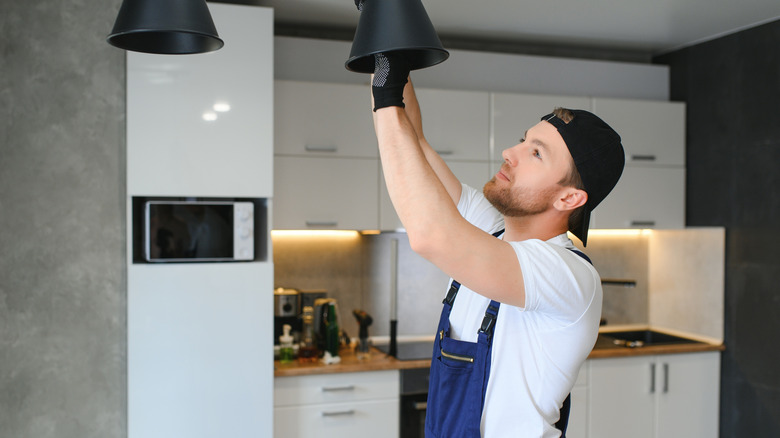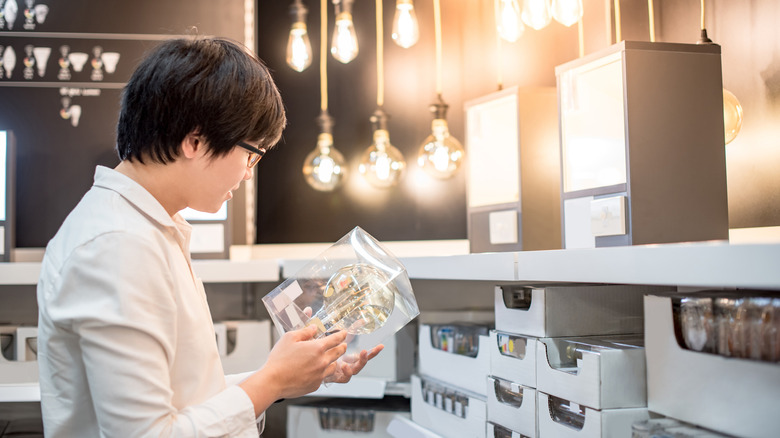Soft White Vs Warm White Lights: How To Choose The Best One For Your Home
Soft white light is the best type of lighting to use in your kitchen, right? Or is it warm white? The names manufacturers use to describe lightbulbs can be downright confusing, especially when you're dealing with monikers as seemingly interchangeable as soft white and warm white. Worse, it can be difficult to choose between them. Should you consider what you do in a room, or focus on how light fixtures affect the color emitting from a bulb? Perhaps you should just trust your perception of the light? It turns out that you must consider all these approaches and engage in a little trial and error of your own to solve the soft white versus warm white conundrum.
To choose the best one for your home, you need to know the science behind these terms. The names refer to the correlated color temperature (CCT) or appearance of a lightbulb measured in Kelvin (K). Soft white encompasses 2,700K to 3,000K, and warm white sits between 3,000K and 4,000K. People buy so-called daylight bulbs thinking they'll make a room brighter, but they're simply confusing light color with illumination. Instead, a soft or warm white bulb provides cozy, natural lighting that's similar to a sunset or sunrise.
Do different rooms require different light temperatures?
Indoor light temperature can influence everything from how cozy we consider a room to be to moral decision-making while working. Because we do different things in each room of a house, the types of lights you should have in every room must be of a different temperature. Warm white light — between roughly 2,700K and 3,000K — is best suited to bedrooms, living rooms, and dining rooms. Soft white bulbs, 3,000K to 5,000K range, are slightly cooler than warm white bulbs. Use them in bathrooms or kitchens for brighter, friendlier, and more task-oriented lighting. To light up a dingy basement, go for a bright white 3,000K bulb.
Conversely, you could also pick a light color, either soft white or warm white, and stick with it throughout your home. You'll avoid jarring experiences as you move from one room to another, and your perception of wall paint hues and decor colors will stay consistent. If you want to make a room brighter, increase the wattage (or lumens, in the case of LEDs) of the bulb. While mixing color temperatures within the same room is ill-advised, it's okay to compromise on this rule in an open plan space if the distinct areas are well defined — say, cooler in the kitchen and warmer in the living room.
Test lightbulb temperatures to find your personal lighting sweet spot
What you do in a room isn't your only consideration. Fixtures matter, too — type, location, and use. A creamy hued linen shade on a floor lamp can make, for example, a warm white bulb appear yellower. What's more, despite the fact that light temperature can be measured quantitatively, we don't all perceive light temperature the same. For example, older people with a common yellowing of their corneas may experience cooler light as warmer, and therefore prefer bulbs on the cooler, or bluer, side of the Kelvin scale. And, it turns out, warm light sources aren't the best option for people with low vision. Conversely, older adult homeowners participating in a 2022 study for The Center for Health Design reported that amber hued bulbs made nighttime trips to the bathroom safer.
You might just be able to ignore labels like soft white, warm white, and similar descriptions on lightbulb packaging altogether. These terms are crafted by bulb manufacturers for marketing purposes and aren't even close to standardized. One manufacturer's soft white bulb could be another's warm white. In fact, bulbs in the 2,700K range are often described as warm white or soft white interchangeably. Since, generally, all warmer light temperatures are cozy and inviting, look for the Kelvin rating — it should be printed on the packaging — to give you a better idea of how to choose the perfect lighting for your space, temperature-wise. Ultimately, it comes down to individual preferences and trial and error. Try out bulbs at different points on the warmer end of the Kelvin scale until you find the temperature that resonates.


